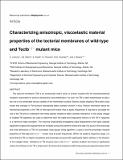| dc.contributor.author | Lemons, Charlsie | |
| dc.contributor.author | Sellon, Jonathan Blake | |
| dc.contributor.author | Boatti, Elisa | |
| dc.contributor.author | Filizzola, Daniel | |
| dc.contributor.author | Freeman, Dennis M | |
| dc.contributor.author | Meaud, Julien | |
| dc.date.accessioned | 2021-09-27T17:37:41Z | |
| dc.date.available | 2021-09-27T17:37:41Z | |
| dc.date.issued | 2019-02 | |
| dc.date.submitted | 2018-10 | |
| dc.identifier.issn | 0006-3495 | |
| dc.identifier.uri | https://hdl.handle.net/1721.1/132650 | |
| dc.description.abstract | The tectorial membrane (TM) is an extracellular matrix that is directly coupled with the mechanoelectrical receptors responsible for sensory transduction and amplification. As such, the TM is often hypothesized to play a key role in the remarkable sensory abilities of the mammalian cochlea. Genetic studies targeting TM proteins have shown that changes in TM structure dramatically affect cochlear function in mice. Precise information about the mechanical properties of the TMs of wild-type and mutant mice at audio frequencies is required to elucidate the role of the TM and to understand how these genetic mutations affect cochlear mechanics. In this study, images of isolated TM segments are used to determine both the radial and longitudinal motions of the TM in response to a harmonic radial excitation. The resulting longitudinally propagating radial displacement and highly spatially dependent longitudinal displacement are modeled using finite-element models that take into account the anisotropy and finite dimensions of TMs. An automated, least-square fitting algorithm is used to find the anisotropic material properties of wild-type and Tectb−/− mice at audio frequencies. Within the auditory frequency range, it is found that the TM is a highly viscoelastic and anisotropic structure with significantly higher stiffness in the direction of the collagen fibers. Although no decrease in the stiffness in the fiber direction is observed, the stiffness of the TM in shear and in the transverse direction is found to be significantly reduced in Tectb−/− mice. As a result, TMs of the mutant mice tend to be significantly more anisotropic within the frequency range examined in this study. The effects of the Tectb−/− mutation on the TM’s anisotropic material properties may be responsible for the changes in cochlear tuning and sensitivity that have been previously reported for these mice. | en_US |
| dc.description.sponsorship | National Institutes of Health (Grant R01-DC000238) | en_US |
| dc.publisher | Elsevier BV | en_US |
| dc.relation.isversionof | http://dx.doi.org/10.1016/j.bpj.2018.12.019 | en_US |
| dc.rights | Creative Commons Attribution-NonCommercial-NoDerivs License | en_US |
| dc.rights.uri | http://creativecommons.org/licenses/by-nc-nd/4.0/ | en_US |
| dc.source | Prof. Freeman via Phoebe Ayers | en_US |
| dc.title | Characterizing anisotropic, viscoelastic material
properties of the tectorial membranes of wild-type and Tectb−/− mutant mice | en_US |
| dc.title.alternative | Anisotropic Material Properties of Wild-Type and Tectb−/− Tectorial Membranes | |
| dc.type | Article | en_US |
| dc.identifier.citation | Lemons, Charlsie et al. "Anisotropic Material Properties of Wild-Type and Tectb−/− Tectorial Membranes." Biophysical Journal 116, 3 (February 2019): 573-585. © 2019 Biophysical Society | en_US |
| dc.contributor.department | Massachusetts Institute of Technology. Department of Electrical Engineering and Computer Science | en_US |
| dc.contributor.department | Massachusetts Institute of Technology. Research Laboratory of Electronics | en_US |
| dc.relation.journal | Biophysical Journal | en_US |
| dc.eprint.version | Author's final manuscript | en_US |
| dc.type.uri | http://purl.org/eprint/type/JournalArticle | en_US |
| eprint.status | http://purl.org/eprint/status/PeerReviewed | en_US |
| dspace.date.submission | 2021-03-05T16:02:15Z | |
| mit.journal.volume | 116 | en_US |
| mit.journal.issue | 3 | en_US |
| mit.license | PUBLISHER_CC | |
| mit.metadata.status | Complete | en_US |
